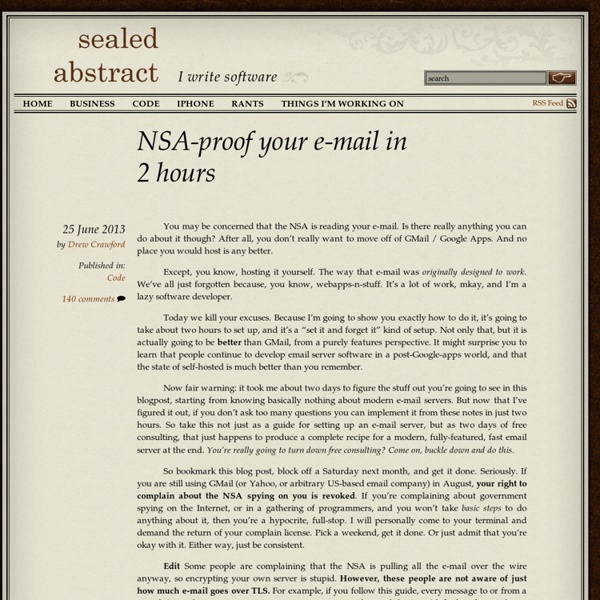NSA-proof your e-mail in 2 hours

You Are the Network
btcd: Not your mom’s Bitcoin daemon | Conformal Systems, LLC.
We are pleased to announce that btcd, our full-node bitcoind alternative written in Go, is finally ready for public testing! The installation instructions and source code can be found on github at: A Brief History Back in May, we first announced our plans to release btcd. Over the next month, we released btcjson, btcdb, and btcscript. What Took so Long? As typically happens with development, several things came up, all of which took a few days (or a week) here and there. The following list is a brief overview of the various things that were tackled: So, as you can see from the list above, we were able to cram quite a bit in 10 weeks! Separate Chain and Wallet While implementing the wallet and starting to build the GUI, we quickly realized that there is, what we consider, a fundamental design flaw in the other implementations we have seen to date. Why Separate Chain and Wallet? Multiple devices and thin wallets can also be supported based on this design.
Sovereign Peer-to-Peer
nanomsg
Bittorrent in a P2P social network
SSD Myths and Legends - "write endurance" article in StorageSearch.com
This, below, is the original text of my SSD endurance article published in March 2007 Does the fatal gene of "write endurance" built into flash SSDs prevent their deployment in intensive server acceleration applications? It was certainly true as little as a few years ago (2005). What's the risk with today's devices? Flash based solid state disks would seem to be the ideal virtual storage device... In every other respect you can treat them in exactly the same way as a hard drive:- same interface, same software model. In the smaller form factors like 1.8" and 2.5" - the gap in capacity between SSDs and hard drives has disappeared. What's wrong with this utopian vision? And why is it that even if you were offered a flash SSD accelerator for your server absolutely FREE you might still hesitate about installing it? The answer explains why the flash SSD server acceleration market still isn't a billion dollar plus market - even 4 years after I first posed this exact same question.
Air pollution monitoring stations face closure as government looks to cut costs | Environment
Up to 600 stations for monitoring air pollution across England could be shut down under new government plans to save money by cutting regulations. Ministers want to remove obligations on local authorities to assess air quality in their areas, resulting in less monitoring. But environmental campaigners are accusing them of trying to hide one of the country's biggest public health problems. Government advisers have estimated that one type of pollutant – miniscule particles from diesel engines, fossil fuel power stations and other sources – is killing 29,000 people a year in the UK, and costing health services about £16bn. But European air pollution limits meant to protect health are being breached in urban areas across the country, with the highest levels in London. But now Defra has launched a six-week consultation, due to close on 30 August, proposing a radical overhaul of the local air quality management regime that has been in place since 1997.
Particulates
This diagram shows types, and size distribution in micrometres, of atmospheric particulate matter This animation shows aerosol optical thickness of emitted and transported key tropospheric aerosols from 17 August 2006 to 10 April 2007, from a 10 km resolution GEOS-5 "nature run" using the GOCART model.[1][2] (click for more detail) * green: black and organic carbon * red/orange: dust * white: sulfates * blue: sea salt Movie map of distribution of aerosol particles, based on data from the Moderate Resolution Imaging Spectroradiometer (MODIS) on NASA’s Terra satellite. * Green areas show aerosol plumes dominated by larger particles. * Red areas show aerosol plumes dominated by small particles. * Yellow areas show where large and small aerosol particles are mixing. * Gray shows where the sensor did not collect data. Atmospheric particulate matter – also known as particulate matter (PM) or particulates – is microscopic solid or liquid matter suspended in the Earth's atmosphere.
Related:
Related:



